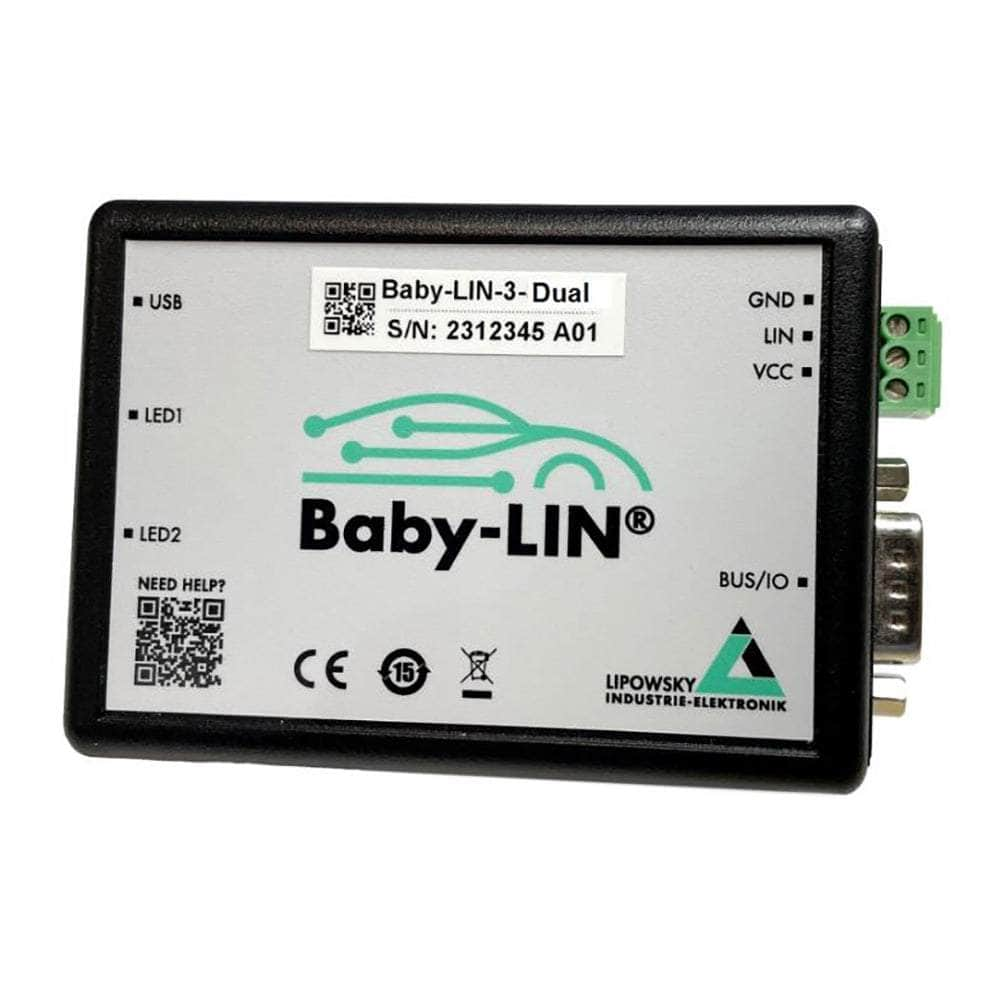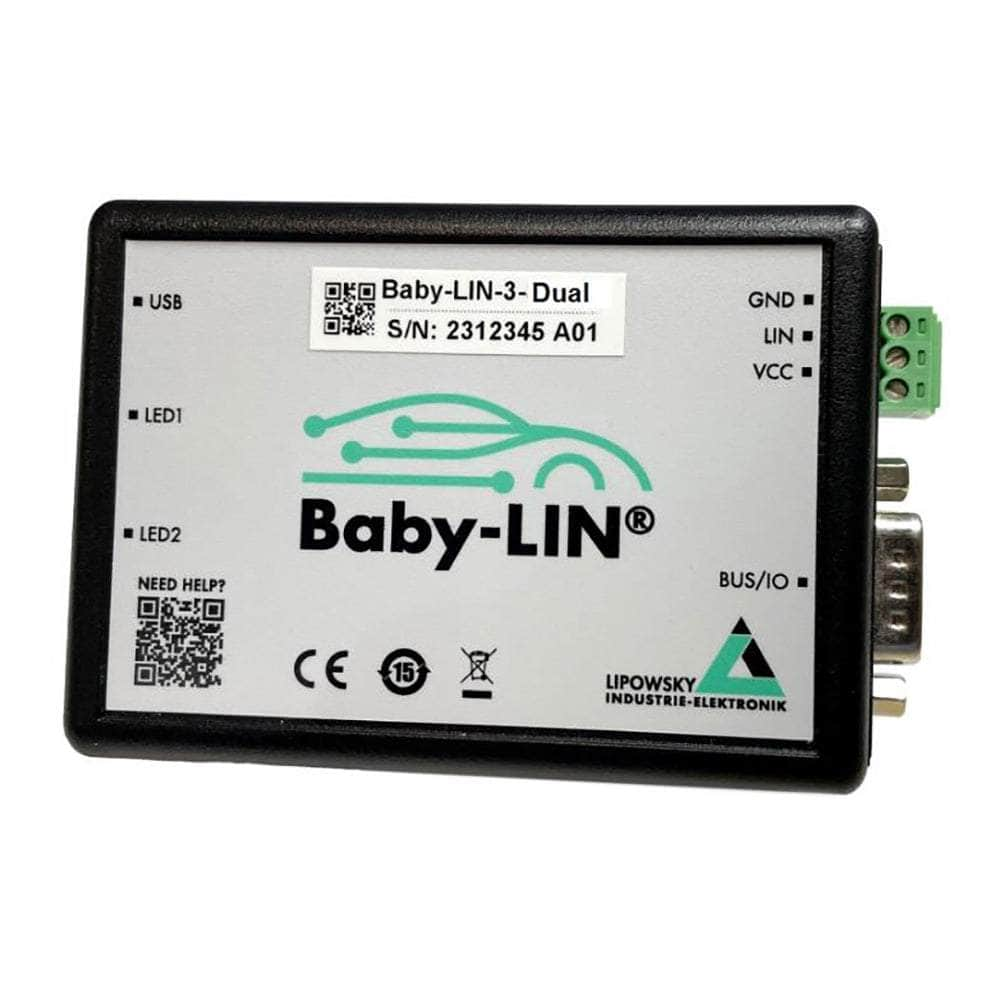
Key Features
Overview
Professional LIN and CAN Bus Testing Made Simple
The Lipowsky Baby-LIN-3-Dual represents the pinnacle of compact bus simulation technology, combining both LIN and CAN interfaces in a single, galvanically isolated device. Built around a powerful 480MHz ARM Cortex-M7 processor, this simulator delivers 60% faster performance than previous generations whilst maintaining the reliability engineers demand.
Featuring comprehensive support for LIN bus versions 1.2 through 2.2 and CAN High-Speed interface (ISO 11898-2) with optional CAN-FD upgrade, the Baby-LIN-3-Dual excels in both laboratory testing and production environments. The device supports bus voltages from 8-28V DC and can operate as master, slave, or in monitoring mode across both protocols simultaneously.
Versatile Testing Capabilities
Whether you're conducting residual bus simulations, end-of-line testing, or developing new ECU software, the Baby-LIN-3-Dual adapts to your workflow. The included LINWorks software suite provides comprehensive tools for LDF editing, session configuration, and real-time bus monitoring. Advanced users can leverage the Baby-LIN DLL with wrappers for C/C++, .NET languages, Python, LabVIEW, and VB6.
The device's standalone capability sets it apart from competitors, enabling autonomous operation without PC connection for endurance testing and production applications. With 32MB RAM and extended 500KB SDF memory, complex test scenarios execute reliably even in demanding industrial environments.
For enhanced connectivity, the Baby-LIN-3-Dual features a high-speed USB 2.0 interface with USB-C connector, ensuring fast data transmission and easy integration with modern test systems. Compatible with Windows 10/11 and various Linux distributions, it seamlessly fits into existing development workflows.
Downloads
Why Engineers Choose The Lipowsky Baby-LIN-3-Dual LIN-Bus-Simulator
Accelerated Development Cycles
Production Line Integration
Comprehensive Protocol Support
Überblick
Das Lipowsky Baby-LIN-3-Dual ist ein vielseitiges LIN- und CAN-Bus-Simulationsgerät, mit dem Sie LIN- und CAN-Kommunikation einfach von einem PC aus steuern, überwachen und testen können.
Hauptmerkmale
- 480 MHz Cortex M7-Prozessor für 60 % schnellere Leistung als Vorgängermodelle
- High-Speed 480MBit/s USB 2.0 Schnittstelle mit USB-C Anschluss
- 32 MB RAM und erweiterter 500 KB SDF-Speicher
- Unterstützung für LIN-Busspannungen von 8-26 VDC bei Geschwindigkeiten bis zu 115200 Baud
- Galvanisch getrennte Kommunikationsschnittstellen
- Auswahl an LIN- und CAN-Bus-Simulationsmodi
- Inklusive Lizenz für Lipowskys LINWorks-Software-Suite
Anwendungen
Der Baby-LIN-3-Dual kann in zahlreichen Situationen eingesetzt werden, in denen eine Kommunikation mit LIN- oder CAN-Geräten erforderlich ist, darunter:
Forschung und Entwicklung
- Simulieren Sie LIN- und CAN-Netzwerke während der Entwurfs- und Testphase
- Busdaten zur Analyse aufzeichnen, ohne dass ein PC angeschlossen ist
Herstellung und Qualitätsprüfung
- Durchführen von End-of-Line-Tests (EOL) an der Produktionslinie
- Führen Sie Haltbarkeitstests durch, indem Sie vorprogrammierte Befehlssequenzen ausführen
Wartung und Reparatur
- Schnelle Problemdiagnose durch Live-Überwachung des Busverkehrs
- Identifizieren Sie fehlerhafte Steuergeräte bei der Fehlersuche
LIN- und CAN-Bus-Unterstützung
Die integrierten LIN- und CAN-Bus-Treiber bieten umfassende Protokollunterstützung:
LIN-Bus
- LIN-Versionen 1.2 und höher
- Kühlung und SAE J2602-Standards
- Baudraten bis zu 115200
- 8-26VDC-Betrieb
CAN-Bus - Datenübertragung
- ISO 11898-konforme Schnittstelle
- CAN 2.0- und CAN FD-Unterstützung
- Bis zu 8MBit/s CAN FD-Datenraten
Simulationsfunktionen
Der Baby-LIN-3-Dual kann eine Vielzahl von Knotenkonfigurationen simulieren:- Master- und Slave-Verhalten
- Vollständige Replikation des Busverkehrs
- Restbussimulation mit allen Knoten außer einem
- Passive Busüberwachung ohne Knoten
Gleichzeitige LIN- und CAN-Simulationen werden unterstützt.
Mitgelieferte LINWorks-Software
Der Baby-LIN-3-Dual wird mit Lipowskys LINWorks-Suite zur Verwaltung von LIN- und CAN-Bus-Projekten geliefert. LINWorks-Funktionen:- LDF-Bearbeitung
- SD-Dateierstellung
- Bussteuerung, Überwachung und Protokollierung
- Beispieldateien und Dokumentation
| General Information | |
|---|---|
Part Number (SKU) |
8001023
|
Manufacturer |
|
| Physical and Mechanical | |
Weight |
0.5 kg
|
| Other | |
Warranty |
|
HS Code Customs Tariff code
|
|
EAN |
5055383692231
|
Frequently Asked Questions
Have a Question?
-
What connectivity options are available?
The device features a high-speed USB 2.0 interface with USB-C connector for fast 480Mbit/s data transmission. LIN connections use 3-pin screw terminal connectors, while CAN interfaces utilise standard SUB-D9 connectors for industry-standard connectivity.
-
Is the device compatible with Linux operating systems?
Yes, the Baby-LIN-3-Dual supports Windows 10/11 (32/64-bit) and provides DLL interfaces for PC-based Linux (x86 & x64) and ARM-based Linux systems, ensuring broad compatibility across development platforms.
-
How does galvanic isolation benefit automotive testing?
Galvanic isolation prevents electrical interference between test equipment and target systems, eliminating ground loops and protecting valuable ECUs from potential damage. This ensures reliable data transmission and maintains signal integrity during critical testing procedures.
-
What voltage ranges does the device support?
The Baby-LIN-3-Dual supports bus voltages from 8-28V DC, accommodating both 12V passenger vehicle systems and 24V commercial vehicle applications. LIN bus specifically operates within 8-26V DC range with baud rates up to 115,200.
-
Can the device simulate both master and slave nodes simultaneously?
Yes, the Baby-LIN-3-Dual can simultaneously simulate LIN master/slave nodes and CAN nodes across both protocols. It supports residual bus simulation where all but one node is simulated, complete bus simulation, or passive monitoring configurations.
-
What makes the Baby-LIN-3-Dual superior to competitive solutions?
Unlike basic CAN interfaces or software-only solutions, the Baby-LIN-3-Dual combines hardware-accelerated protocol handling, galvanic isolation, dual-protocol support, and standalone operation. This integration provides reliability and performance advantages over separate tools or PC-dependent solutions.
-
Does the device support CAN-FD protocol?
The Baby-LIN-3-Dual includes CAN High-Speed interface (ISO 11898-2) as standard. CAN-FD functionality is available as an optional upgrade through a paid activation voucher, providing future-proof protocol support.
-
What software is included with the Baby-LIN-3-Dual?
The device includes a comprehensive LINWorks software suite featuring LDF editor, session configurator, bus monitoring tools, and sample files. The Baby-LIN DLL provides API access for custom applications in C/C++, .NET, Python, LabVIEW, and VB6.
-
Can the device operate without a PC connection?
Yes, the Baby-LIN-3-Dual features standalone operation capability. Once programmed with test sequences, it can execute autonomous testing routines without PC connectivity, making it ideal for production environments and endurance testing scenarios.
-
What LIN bus versions does the Baby-LIN-3-Dual support?
The Baby-LIN-3-Dual supports LIN bus versions 1.2, 1.3, 2.0, 2.1, and 2.2, providing comprehensive compatibility with modern automotive systems. It also supports Cooling and SAE J2602 standards for specialised applications.

